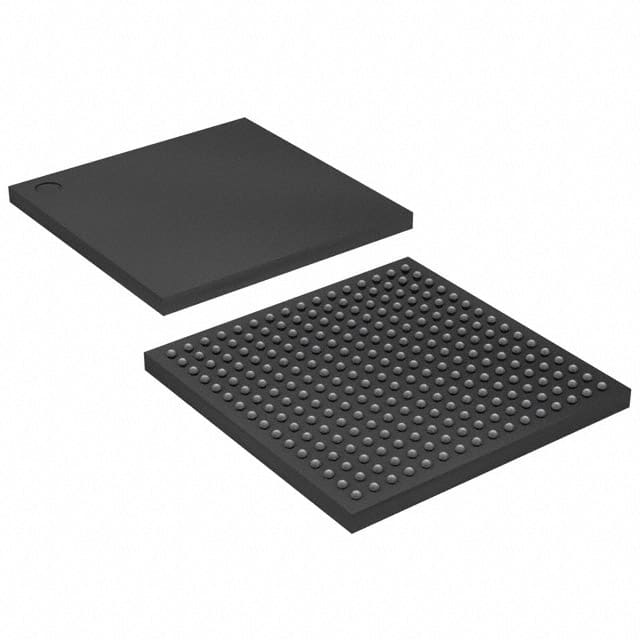Lihat spesifikasi untuk detail produk.

EP3C10U256C8
Product Overview
Category: Programmable Logic Device (PLD)
Use: The EP3C10U256C8 is a programmable logic device designed for various digital applications. It offers flexibility and versatility in implementing complex digital circuits.
Characteristics: - High-performance FPGA (Field-Programmable Gate Array) - Low power consumption - Small form factor - Wide range of I/O options - Configurable logic blocks - Embedded memory blocks - On-chip PLL (Phase-Locked Loop) - Support for various communication protocols
Package: The EP3C10U256C8 comes in a compact 256-pin plastic quad flat pack (PQFP) package, which ensures easy integration into circuit boards.
Essence: This PLD provides designers with the ability to create custom digital circuits that can be reprogrammed as needed, offering flexibility and cost-effectiveness compared to traditional fixed-function integrated circuits.
Packaging/Quantity: The EP3C10U256C8 is typically sold individually or in small quantities, depending on the supplier's packaging options.
Specifications
- Logic Elements: 10,080
- RAM Bits: 414,720
- Maximum User I/Os: 179
- Clock Management Tiles: 4
- Maximum User Flash Memory: 270 Kbits
- Maximum User Registers: 414,720
- Operating Voltage: 1.2V
- Operating Temperature Range: -40°C to +100°C
Detailed Pin Configuration
The EP3C10U256C8 has a total of 256 pins, each serving a specific purpose in the device's functionality. For a detailed pin configuration diagram, please refer to the manufacturer's datasheet.
Functional Features
- Configurable Logic Blocks (CLBs): These blocks provide the ability to implement various logic functions, including combinational and sequential circuits.
- Embedded Memory Blocks: The device includes dedicated memory blocks that can be used for storing data or implementing lookup tables.
- Phase-Locked Loop (PLL): The on-chip PLL allows for precise clock generation and synchronization, enabling efficient timing control.
- I/O Options: The EP3C10U256C8 supports a wide range of I/O standards, such as LVCMOS, LVTTL, and differential signaling, providing compatibility with different communication protocols.
Advantages and Disadvantages
Advantages: - Flexibility: The EP3C10U256C8 offers the ability to reprogram the device, allowing for design changes without the need for hardware modifications. - Cost-Effectiveness: Compared to fixed-function integrated circuits, programmable logic devices like the EP3C10U256C8 provide cost savings by eliminating the need for multiple specialized chips. - Versatility: The device can be used in various applications, including telecommunications, industrial automation, consumer electronics, and more.
Disadvantages: - Complexity: Programming and configuring the EP3C10U256C8 requires expertise in digital design and FPGA programming, which may pose a challenge for beginners. - Limited Resources: As a smaller-sized FPGA, the EP3C10U256C8 has limited logic elements and memory compared to larger devices, which may restrict the complexity of designs that can be implemented.
Working Principles
The EP3C10U256C8 operates based on the principles of field-programmable gate arrays. It consists of configurable logic blocks interconnected through programmable routing resources. These logic blocks can be programmed to implement various digital functions, while the routing resources allow for interconnection between different blocks.
The device is programmed using a Hardware Description Language (HDL) such as VHDL or Verilog. The HDL code is synthesized and converted into a configuration bitstream, which is then loaded onto the EP3C10U256C8 to define its functionality.
Detailed Application Field Plans
The EP3C10U256C8 finds applications in various fields, including:
- Telecommunications: Used in base stations, network switches, and routers for signal processing, protocol conversion, and data routing.
- Industrial Automation: Employed in control systems, motor drives, and robotics for real-time control, sensor interfacing, and communication interfaces.
- Consumer Electronics: Integrated into multimedia devices, gaming consoles, and smart appliances for audio/video processing, user interface control, and connectivity features.
- Automotive: Utilized in automotive electronics for engine control, driver assistance systems, and infotainment systems.
- Medical Devices: Incorporated into medical imaging equipment, patient monitoring systems, and laboratory instruments for data acquisition, signal processing, and control functions.
Detailed and Complete Alternative Models
- EP3C16U256C8: A larger version of the EP3C10U256C8 with 16,000 logic elements and increased memory capacity.
Sebutkan 10 pertanyaan dan jawaban umum terkait penerapan EP3C10U256C8 dalam solusi teknis
Sure! Here are 10 common questions and answers related to the application of EP3C10U256C8 in technical solutions:
Q: What is EP3C10U256C8? A: EP3C10U256C8 is a field-programmable gate array (FPGA) device manufactured by Intel (formerly Altera). It offers programmable logic, memory, and digital signal processing capabilities.
Q: What are the key features of EP3C10U256C8? A: Some key features of EP3C10U256C8 include 10,080 logic elements, 414 kilobits of embedded memory, 288 user I/O pins, and support for various communication protocols.
Q: In what applications can EP3C10U256C8 be used? A: EP3C10U256C8 can be used in a wide range of applications such as industrial automation, robotics, telecommunications, automotive systems, medical devices, and more.
Q: How can EP3C10U256C8 be programmed? A: EP3C10U256C8 can be programmed using hardware description languages (HDLs) like Verilog or VHDL, which describe the desired functionality of the FPGA.
Q: Can EP3C10U256C8 interface with other components or devices? A: Yes, EP3C10U256C8 supports various communication protocols like SPI, I2C, UART, and Ethernet, allowing it to interface with other components or devices in a system.
Q: What tools are available for designing with EP3C10U256C8? A: Intel provides Quartus Prime software, which includes a suite of tools for designing, simulating, and programming EP3C10U256C8-based solutions.
Q: Can EP3C10U256C8 be reprogrammed after deployment? A: Yes, EP3C10U256C8 is a reprogrammable FPGA, meaning its configuration can be changed even after it has been deployed in a system.
Q: What are the power requirements for EP3C10U256C8? A: EP3C10U256C8 typically operates at a voltage of 1.2V and requires additional voltages for I/O pins, which can range from 1.5V to 3.3V depending on the application.
Q: Are there any limitations or considerations when using EP3C10U256C8? A: Some considerations include the limited number of logic elements and memory available in EP3C10U256C8 compared to larger FPGAs, as well as power consumption and heat dissipation.
Q: Where can I find more information about EP3C10U256C8? A: You can find more detailed information about EP3C10U256C8 in the datasheet provided by Intel (formerly Altera) or by referring to online resources and forums dedicated to FPGA design.

